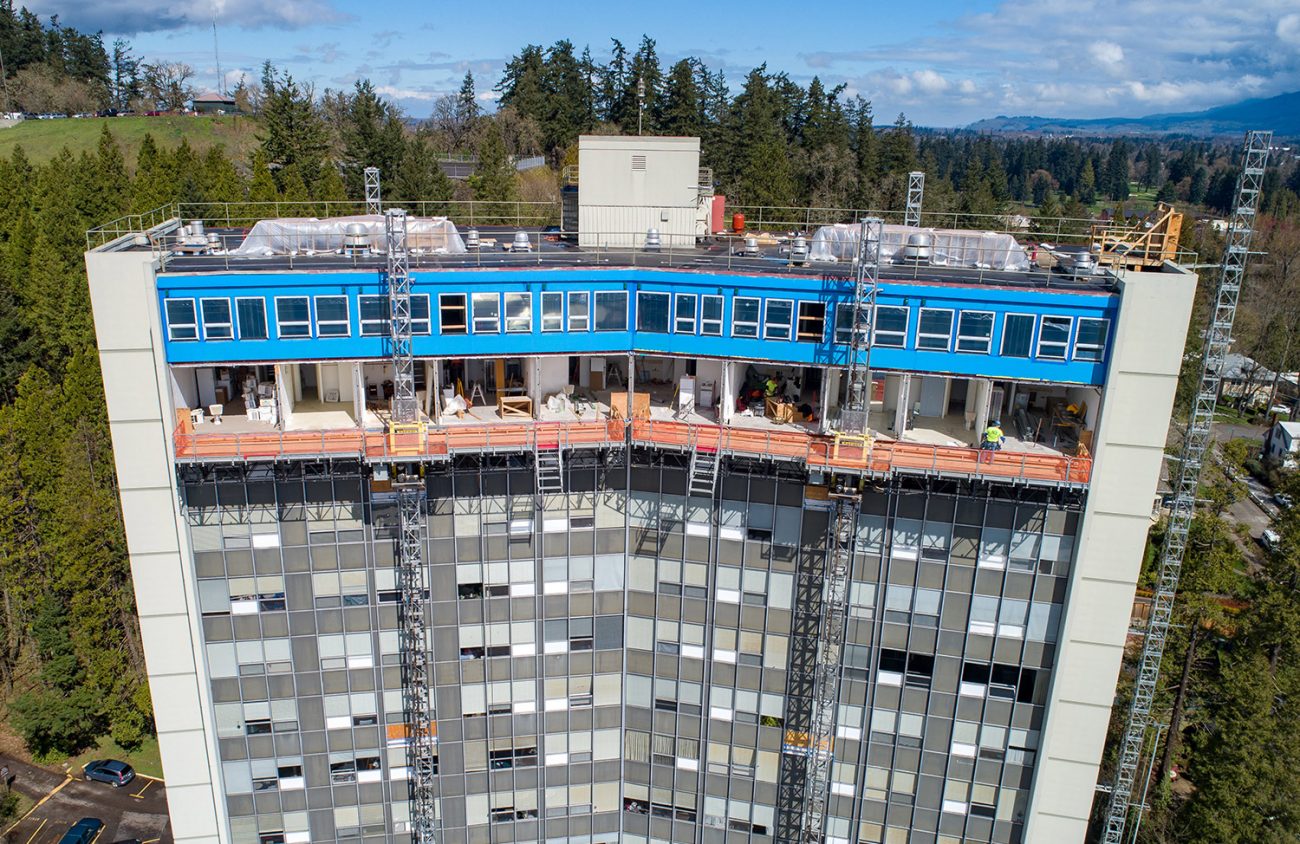Oregonians young and old are sounding the alarm in communities across the state. They are attending town hall meetings, protesting pipelines, setting up treesits and taking other forms of direct action to address climate change.
If you look to the top of the Ya-Po-Ah Terrace apartment tower in downtown Eugene, dangling 200 feet above the ground you will see a prime example of local climate action. Clad in bright-colored helmets and full body harnesses, the team has been planning this direct action for well over a year now.
These are not protesters. They are employees of more than a dozen Eugene-based businesses such as BrandSafway Services, FM Sheet Metal, Ferguson, Twin Rivers Plumbing and Integrated Electronic Systems, among others. They are taking on the quiet, smart, energy-saving, easily overlooked and thankless task of transitioning this building off of fossil fuels.
It’s not exciting and it doesn’t make headlines, but it does create living-wage jobs and it saves money. Most important, this is precisely the kind of work we must scale up quickly and apply to buildings all across Eugene (and buildings across the entire country, for that matter) if we are going to wean ourselves off of fossil fuels within just a few short decades.
Making energy upgrades to this building is a prime example of smart climate action because it begins with equity. Ya-Po-Ah Terrace houses hundreds of low-income seniors who pay a modest rent, proportional to their income. If we are to make a serious effort to transition our energy system off of fossil fuels, affordable housing projects like this one, as well as homes and apartments rented by families on limited incomes, must be the first place we focus our energy efficiency efforts.
This will help ensure that those who are most at risk and those with the fewest resources will be the first to benefit, rather than the first to be left behind. With equity at its core, the process of swiftly transitioning off of fossil based energy sources rests on three “pillars.”
The first pillar is radical energy efficiency. It will be delivered to Ya-Po-Ah Terrace when workers install new insulation that will nearly triple the insulation values in the exterior walls and floors. Skilled hands will replace 18 floors of glass with new energy-efficient triple pane windows. Specialists will install an energy recovery ventilation (ERV) system that borders on magic. The ERV reuses the heat from the outgoing stale air to warm up the incoming cold fresh air, saving a ton of energy in the process. With these and other efficiency upgrades, the energy bills for the Ya-Po-Ah terrace will fall by 45 percent, and the total energy use will fall by a jaw-dropping 63 percent.
For pillar two, we electrify everything, a step that enables us to run more of our economy (and this building in particular) on any variety of renewable energy sources including wind, solar, geothermal and hydropower. Electricians and heating equipment technicians will work at Ya-Po-Ah replacing the gas-fired furnace with an energy-efficient, electric-powered heating and cooling system. Switching over from gas heat to electric heat will cause the gas use in the building to plummet by 90 percent.
The last pillar is moving to 100 percent renewable electricity. That has less to do with the actions at Ya-Po-Ah Terrace and more to do with local — like EWEB — state and federal policies and investments. Even with our relatively low-carbon electricity, we will need to install more renewable electricity generation in our region if we are going to run most of our economy on renewable energy.
That’s how it gets done. One building. Three pillars. Nobody has to live in caves. Nobody is deprived of basic comforts. Yes, it requires effort and money and change and leadership, but the task in front of us is no mystery. It’s just smart, money-saving, job-creating investment.
This project will see investment from multiple sources including the state of Oregon Housing and Community Services, U.S. Department of Housing and Urban Development, the city of Eugene and EWEB, among others. Smaller scale projects like home energy retrofits won’t need this scale of funds, but they will require public policies that support renewable energy, energy conservation, and convenient access to financing.
Whether blocking the path of a pipeline or balancing on scaffolding 18 stories above the ground to transform a building, each requires skill, focus and fair dose of courage. These are the same qualities we need from our government leaders right now as we call on them to expedite the transformation of our entire energy system.
Matt McRae is the climate policy strategist for Our Children’s Trust and served as the Climate and Energy Analyst for the city of Eugene for eight years.
